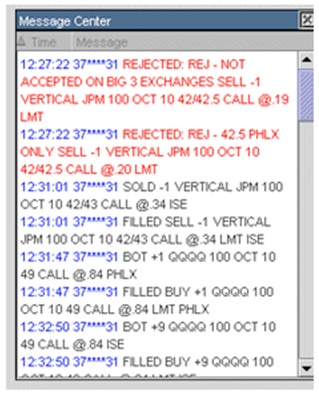Recently, I was teaching an option class in Overland Park, Kansas, and we were looking at placing a short vertical (bear call) on JPMorgan Chase (JPM). We noticed that the underlying did not trade over 42 for a while, hence, we selected the 42 zone as the correct place to sell the short call. The students and I anticipated that if there were no single strike increments since JPM was trading just around 40—a few pennies off—we anticipated to see at least a 42.50 strike price, which would still be good for our technically based trade. In such a case, with 2.50 strike increments, our trade would be composed of a short 42.50 call and a protective 45 call. Certainly a better credit could be produced if the strikes were in single-point increments. Had that been the case, the students and I would sell the 42 call and buy the 43 call.
At any rate, after completing our initial chart examination, we glanced at the JPM option chain. Unlike Bank of America (BAC), which has weekly options listed, JPM did not have weeklies. Selling a short vertical spread, in that case, gave us the October choice. As a seller, we should always aim to sell the front month, or the shortest amount of time during which our money will be held in maintenance.
To our surprise, this is what we observed: Figure 1 shows that the listed strike prices were 37, 38, 39, 40, 41, 42, 42.50, 43, 44, and 45. Instantly, I knew that originally the market makers had only 40, 42.50, and 45 listed, yet as more demand came along, they provided the supply by creating single-point strikes.
Hence, having a situation as such, I recomputed the calculation for our short vertical credit spread. The prices involved in this particular scenario were still short 42 call and long 42.50 call. The credit received turned out to be close to 20 cents, yet the spread being only 50 cents (long 42.50 call minus the short 42 call) gave us the potential maximum loss of only 30 cents. The calculation of ROR, the rate of return, would be (the maximum profit/reward divided by maximum debit/loss) .20/.30. These two numbers can get reduced to the fraction form of two thirds (2/3), which means that our return would be 67% as long as JPM closes below 42 on October expiry.
This trade, initially for educational purposes only, appeared attractive to me, so I actually went ahead and placed it, only to have my order wait for the fill longer than what is customary. Secondly, after all that, my platform displayed a rejection message, of which I took a print screen:
Article Continues on Page 2
|pagebreak|As you can see, the first message communicated that out of 6 major option exchanges (CBOE, ISE, AMEX, PHLX, NYSE, and BOX), three exchanges instantly rejected. The second message indicates that my broker attempted one more time to send it directly to the Philly exchange (PXLX), and the trade was rejected again. Being the curious person I am, I instantly called my broker/trade desk to find out if they could "Force the trade from their end." I spoke with Scott S. (second in charge) and after he personally took time to take a closer interest in it, I was informed that the October 42.50 call at this point could be only closed and not opened. Again, I am emphasizing the word “closed,” for it does not matter if somebody is performing the action of selling or buying. The action permitted by the exchanges since they added the single-point strike increments was only either BTC (buy to close) or STC (sell to close). In my order, I was attempting to BTO (buy to open) the October 42.50 call. Scott S. did comment that things such as this happen on rare occasions, with JPM being one of those occasions.
As could be seen from the Message Center box, I still liked the trade, so I changed it from the initial one (-42 call/+42.50 call) to –42 call/+43 call. Yet with this, the whole ROR changed as well. Under the new circumstances, my maximum credit, if JPM closes below 42 on the October expiration, is only 0.34, while my risk is now (43c – 42c = 1.00 minus 0.34) 0.66 cents. ROR being then .34/.66 = 51%, I still took the trade, but only with a single lot.
In conclusion, having strike spreads in single-dollar increments on an underlying that is trading over 100 (such as SPY) is already great, but having 50-cent strike spreads on a stock that trades around 40 dollars would be just as good. However, there is always something hidden in the fine print (or hidden behind the scenes), and when things don't work out the way they should, it is easy to conclude that, once again, when something sounds too good to be true, then it most likely is.
By Josip Causic, instructor, Otnline Trading Academy






















